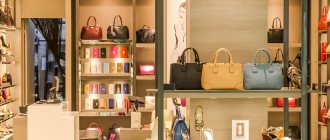In the 21st century, a huge share of the retail market has gone to full and partial self-service stores. People have developed a culture of independently purchasing not only everyday goods, but also household appliances and electronics. But with all this, the desire of retail to influence consumer behavior remained, and in this process a large role was assigned to store merchandising, which is designed not only to create a convenient and comfortable environment for the buyer in the store, but also to influence his choice.
Merchandising is an art - 6 laws in simple words
I am sure that every entrepreneur has heard this word. After all, merchandising is the art of selling, its basis and support. This is what all business trainers in the retail sector and the like say without exception. But not every entrepreneur and seller knows all the subtleties of merchandising.
Let's try to break everything down in the simplest terms. And in the end, we’ll figure out why marketing and merchandising are completely different things in sales.
During my childhood, and these were the dashing nineties, I always wondered why imported products were so bright and colorful, while ours were colorless and bland? Those who lived in those days remember how fashionable it was to collect all kinds of packaging from chewing gum, chocolate bars and beer cans.
Everything that was brought “from there” was so desirable and attractive that the food packaging was not thrown away for several years after it was consumed. Moreover, this all happened against the backdrop of a general shortage of goods in the country.
Objectives and tools of visual merchandising
Visual merchandising is based on stimulating sales, obtaining maximum profits by persuading customers to make unplanned purchases.
If we talk about the general goals of visual merchandising, then these are sales, or rather, increasing their volumes. And if we take applied tasks, then among them is the visual design of shop windows according to all the rules of visual perception. This area of merchandising is of greatest value for clothing and accessories stores, shoes, jewelry - that is, for those where small-sized products are presented in large quantities.
Visual merchandising techniques are applicable both in large areas of the sales floor and in small rooms. For the latter, the use of “visual” design can be even more useful - here it is much more important to stimulate customers to make additional, spontaneous purchases.
We all come from childhood
At that time, I had a strong feeling that a domestic product could not look as bright as an imported one. It seemed that as soon as the “English” letters were changed to “ours”, all the coolness of the packaging could immediately disappear.
It was only later that marketers, packaging designers and merchandisers appeared in our latitudes. They brought order to the market and even transformed the very attitude of sellers towards buyers.
Aunt Glasha is the best merchandiser
After all, even in Soviet times, the seller behind the counter was considered the standard of ignorance and rudeness. And empty shelves in the store were perceived as completely ordinary and did not surprise anyone.
And people weren’t even amazed by the fact why the “Fish” store sold minced beef, while at the “Meat” store there was a line for herring. Do you remember these packages from your childhood? Against the background of this gray design, everything imported was perceived as if from another planet.
Children are the most grateful connoisseurs of merchandising. They simply cannot ignore all these innovations in the store. They immediately pull parents by the hand, demanding to buy a new product). And for some reason, they place all these children’s pranks right next to the cash register when you’re standing in line.
Merchandising is, first of all, the art of presenting a product so that the buyer wants to buy it. Let's figure out where this craft, necessary for increasing sales, comes from.
When did merchandising appear?
Presumably this phenomenon originated at the dawn of humanity and, most likely, even before the advent of the first money. People, exchanging goods and services, had to somehow communicate with each other.
And since in those days each tribe had its own language, the goods on the market were placed intuitively for the buyer. Yes, the first merchandisers are market sellers. After all, sometimes, in order to beautifully arrange the goods, it came to fights and internecine wars.
All the dullness and emptiness of stores that we had in the dashing nineties was recorded in the United States during the era of the Great Depression. Then store owners began to use various kinds of tricks to lure customers to them. After all, essentially the goods in the stores were the same.
By the way, all free lessons are now in one place. Here - click here! Now you can watch everything in one place! Remember that knowledge is not power, but potential power.
And the visual design of the outlet began to come to the fore. That's when marketers began tracking the impact of product design and placement on how much people buy. Merchandising became an independent science in the 70s of the last century.
Who is involved in merchandising?
To fulfill the goals and objectives of merchandising, a store may employ completely different personnel. This can be specially trained merchandisers or ordinary sellers. In the pre-checkout area, merchandising tasks are often assigned to cashiers. In some cases, loaders are used.
The store planogram itself is developed in advance, even before its opening. Absolutely everything is written out: the location of shelves and racks, where which departments will be located, how the goods will be displayed, etc. Based on this, premises for the store are already being selected; the largest retailers are building store buildings on their own, taking into account their concept. A striking example is IKEA.
Merchandising: what is it and why does no one notice it?
If you want my personal definition. then merchandising is a visual, auditory, kinesthetic and digital impact on a person in order to increase the average check at a retail outlet. Let's take a closer look at all the concepts given in this formulation.
To begin with, let’s accept the fact that the price of a product is 70% of the main factor in making a purchase decision. The remaining 30% of influence is exerted by various factors. Among them is how loyal the buyer is to a particular brand.
By the way, there is an excellent video on this topic on our channel. How exactly does a sale occur when a person goes to a self-service store? Be sure to watch it, it won’t take much time, but it will be extremely useful.
The buyer forms a certain impression about the product in his head. And whether he buys this brand or not depends on this opinion. Merchandising became a separate science as soon as it determined for itself the main goal of influencing people’s attitudes towards a particular product.
How a person perceives information
Let's add some basic knowledge about neurolinguistics and psychology. If you didn’t know, research in these areas of humanity was funded exclusively by marketers for completely mercantile reasons.
Visually
Everything is simple here: the eyes are the most important tool for receiving information from the outside world. More than 60% of the world's population consider vision to be the most preferred channel for communication with the outside world.
In merchandising, impact through this sense organ is achieved through: packaging design, color schemes, lighting, and so on. Everything that a person can visually distinguish among other goods.
Auditory
This communication tool is the main one for 5% of the population. This usually includes people with absolute pitch and musical education. This is a rather rare type of buyer for whom the world of sounds provides the most complete information about the outside world.
Have you heard unobtrusive musical accompaniment in retail outlets? It means you are an auditory learner if you noticed it). But seriously, the soundtrack in the speakers of the shopping center is designed for this category of visitors. One of my business partners is in the process of increasing the average check in supermarkets by introducing musical accompaniment.
Kinesthetically
Smell, heat, cold, humidity, dryness. Soft, hard, rough, prickly, sour, sweet. It's all about kinesthetics. About those people who are focused on sensations. How to recognize such characters? If a person strives to pick up a product or packaging, touch it or smell it, then he is a kinesthetic person.
Marketers organize opportunities for such people to interact with the product in any way. Sometimes they conduct tastings or give a chance to touch the product if it is fabric. Or sit on the sofa, in the case of a furniture exhibition.
Digitally
People who perceive the world in this way are also called discretes. This is a person who perceives information in a structured, balanced and reasoned manner. If he picks up a product, he wants to know what it consists of, its expiration date, who the manufacturer is, the year the company was founded, who is the founder of the brand and who owns the production now).
For this type of people, sellers try to convey information about the product as accurately and structuredly as possible. Such a person should be able to give the seller the most complete answer possible at any time.
By the way, if a buyer is visual or discrete, this does not mean at all that his kinesthetics are completely disabled. This only means that vision for a given individual has priority over other channels of perception.
And now the answer to the main question: what is quality merchandising? Good merchandising simultaneously adapts to all channels of human perception.
Yourselfbranding
That is, it targets a wide target audience. And he does this unobtrusively and unnoticed by ordinary people. Now let's move on to the basic rules.
MerchandisingElena Loginova
1.1. Merchandising concept
In order to understand what merchandising is, you first need to understand its writing. There is no fundamental meaning in the writing of this not-everyone-known term; in some publications it is “merchandising”, in others it is used “merchandising”. Merchandising is a fairly young science, but literature already exists in this area and it becomes possible to competently engage in merchandising in your store. In some publications, this category is identified with the technology of trade processes, the presentation of products on the market, and the organization of a system for promoting the promotion and sale of goods. Some publications and dictionaries discuss the definition of “merchandising” in the retail industry. This approach has a broad definition and practically does not reflect the content of the activities included in the concept of “merchandising”, since merchandising is based on the study of the use value of products, their classification, standardization, assortment, quality, methods of control and evaluation, storage conditions and transportation. Therefore, let us dwell on the concept of merchandising in general.
This word comes from the English merchandise, which means the preparation of goods or any product for distribution or sale. Merchandising
represents one of the categories of consumer psychology, forming and improving the system of distribution of goods in connection with changing needs of people.
Merchandising involves the evaluation and selection of goods and products through the attractiveness of packaging and its design; reliability of labeling and information (description) about the product; selection and assessment of the form, method and style of trading goods; communication with consumers; methods of attracting potential buyers.
Every day people go to a store, supermarket, shopping center, market, every day they buy some product they need. In any store, in any seller-buyer transaction, the interests and goals of both the seller and the buyer are closed. One of the main goals of the seller
is to sell a product, to benefit from it,
the buyer
is to purchase the thing he needs with the greatest benefit for himself.
According to statistics from Russia and European countries, a person makes 2/3 of most purchasing decisions while standing directly in front of a store window or counter. And if the purchase of a specific product was planned in advance, then 7 out of 10 buyers decide to prefer one or another brand of product while already in the store itself, or more precisely, in the sales area at the counter. For example, many people do not make a decision in advance about which ice cream product to buy today. This suggests that in most cases consumers do not have a final decision regarding their preference for a product brand. This decision is made by standing directly in front of the counter, evaluating, and only then making a purchase. The buyer does not evaluate the product, its quality and price before entering the store, he does it in the store. Therefore, there is a need to study a new area of trade marketing - merchandising.
With the development of production and retail trade, fierce competition for the most successful place on the shelf is growing between manufacturers. In order to leave competitors behind, taking advantageous positions in the store, all kinds of merchandising techniques are used, as well as psychological work with employees of the trading enterprise.
According to some experts, the so-called “merchandiser wars” are a fairly common phenomenon. In Russia, this is more typical of the provinces, since in the capital this problem is solved in a civilized manner: most metropolitan retail enterprises, especially large chains, at the very beginning of their work independently allocate the places of goods on the shelves, as well as a rational assortment and area for its display.
A significant factor in the distribution of a product is its share in the local market. The higher the demand for a given product, the more willingly the management of retail outlets allocates aisles for it in order to get maximum profit. Very often the economic feasibility of giving away the most profitable retail locations is calculated; preference is given to manufacturers who themselves encourage and stimulate marketing campaigns. However, priority brands do not always occupy a large share of priority places in the store. The active predominance of an advertised brand may have some influence on the seller in the form of a change in the terms of cooperation or a significant adjustment of the display in favor of the manufacturer. The negative point is the increased dependence on supplies. In this case, in order not to become dependent on the manufacturer, it is profitable for the store to promote a competing brand. The alternative is always effective, and the consumer will be pleased with the increase in the range of goods offered by the store.
Currently, competition is particularly intense among producers of certain types of food products: dairy products, juices, coffee, low-alcohol drinks, water, cigarettes and snack products. Vivid examples are constantly encountered by the average person: Coca-Cola
and
Pepsi,
Wrigley
Company
Orbit, Juicy Fruit
chewing gums and
Dandy
(Stimorol, Dirol trademarks
).
Despite the fact that merchandising is a fairly new phenomenon on the Russian market, there are already quite different definitions of the concept of “merchandising”, which are mostly transformed from foreign literature.
1. The physical location and design of the product at the place of sale, which fully stimulates the buyer to spontaneously purchase it, as well as the accurate presentation and thorough knowledge of the product by the seller - this is one of the perfect interpretations of the concept of merchandising.
2. Merchandising is a set of activities directly or indirectly aimed at increasing sales directly on the sales floor, at the point of sale.
3. Merchandising is a set of measures to prepare goods for sale in a retail network, including the design of shop windows, counters, the location of goods on the sales floor, and the provision of information about the product itself, its production and quality.
4. Merchandising is a set of activities aimed at increasing sales at a particular outlet.
5. Merchandising is retail marketing, the development and implementation of technologies and technical solutions focused on improving the offering of goods and products in the place where the buyer usually comes to make a certain purchase.
6. Merchandising is marketing within the walls of the store.
7. Merchandising is a set of methods for building effective communications between goods and consumers in trade areas.
8. Merchandising is the sales policy of a retailer aimed at promoting and selling specific types and brands of goods in its store, as well as attracting consumers to a specific outlet or store.
9. Merchandising is a set of aspirations to achieve the maximum positive impact on the consumer at the point of sale of a product without the assistance of sales personnel.
10. Merchandising is one of the schemes for promoting goods and products in a store by organizing an atmosphere and aura at a retail outlet or throughout the store that promotes new purchases and acquisitions.
11. Merchandising is a component of marketing, an activity focused on ensuring the most effective promotion of products at the retail sales level through incentives.
There is also such a thing as visual merchandising.
- this is a set of activities carried out in the sales area with the aim of increasing sales and promoting a particular product, brand, brand, type, variety, packaging through their special placement, designing the space of the entire store, display cases and shelving in order to provide the consumer with both as much information as possible about the products.
In a word, merchandising
- the art of marketing, selling, selling goods.
All these and other interpretations of the concept of merchandising indicate that this is an element of marketing, represented by modern schemes for organizing sales and product promotion, designed to collectively express methods and forms of selling goods. It classifies the different types, styles and methods of distribution of products in the retail system.
Some definitions of the concept of merchandising are considered in a broad sense, while others tend to be more narrow, having a more specific practical importance. One interpretation emphasizes its characteristic effect on increasing sales. Thus, in some interpretations, merchandising is considered as a set of activities and actions for the location, packaging and systematization of products in sales areas with the aim of increasing sales - this is a restrictive approach. Other definitions treat merchandising as in-store marketing or as part of integrated marketing communications.
In fact, these two approaches do not contradict each other due to the fact that they characterize merchandising as one of the areas of marketing, defining this activity in the field of product circulation as multilateral and combining technological, economic, behavioral, social and cultural aspects.
Considering merchandising as one of the marketing processes, it is necessary to note the following most significant factors.
1. The display of products on display or special equipment must be thought out to the smallest detail and verified.
2. Advertising materials located at the place of sale of goods must correspond to the image of this outlet or company.
3. Advertising materials must be an attachment to the products displayed in the sales area and at the point of sale, and not just pure advertising.
4. Any advertising and information materials must be executed at a high level.
5. The packaging and appearance of the product must be attractive.
6. It is important to always try to show the maximum possible range of goods or their group.
7. Price tags on goods must be correctly filled out in accordance with all regulatory sales requirements and contain information that is understandable, useful and necessary for the consumer.
8. The place of display and location of goods in the sales area must be thought out in a certain way: the level of visibility of the goods, the opportunity to get acquainted with it, lighting, etc.
9. It is necessary to control the actions and policies of competitors in the promotion and sale of similar products.
10. It is necessary to carry out full training and selection of sellers. This includes 2 main and largely decisive factors:
1) sellers must know all the main characteristics of their products: quality, production technology, rules of consumption or operation, differences from similar products of competing companies, advantages of this product of this particular production;
2) sellers must be sociable, artistic, and have a perfect culture of communication with clients; be able to present your product and sell it so that the buyer, after purchasing the product, comes again or tells his friends about this product and the service in this store.
Thus, merchandising can be defined as the organization and management of the trading process at a retail outlet. The concept of “merchandising” includes a lot of factors: effective layout of the sales floor, selection and placement of retail equipment, display of products, managing the attention and behavior of consumers in the store, etc. [1]
It is necessary to know all of the above merchandising factors and not to miss any of them when preparing to sell any product, otherwise the maximum possible profit will not be achieved.
In the West, they have long paid special attention to the correct presentation of goods in the store, because competition does not stand still, it is intensifying, production conditions and quality are similar, which means that you cannot make special use of the difference in price (although this is significant). Therefore, there is a merchandising process that helps to show, offer and sell products more elegantly, sophisticatedly and skillfully, more extravagantly and unusually. We can say that this is a struggle for the buyer, in which it is not the strongest who wins, but the wisest.
There is a theory that more than 50% of success in the sales business depends on presenting the product to each specific buyer. Moreover, this applies to both well-thought-out large purchases and daily purchases of essential goods and food products.
Obviously, these considerations apply primarily to those consumers who, while in the store, have the required amount of funds to purchase the product they like. But you should never forget about those customers who came to look today and will return to buy tomorrow.
The goods must not only be brought to the store in the required quantity, hastily attached with price tags and sold at a favorable price. It must be presented correctly and intelligently, i.e. packaging, display, location, advertising, presentation of the product by sellers must be at a higher level than that of competitors. These factors do not exhaust the list of requirements for product presentation - they are the fundamental basis for the implementation of commercial plans. Therefore, merchandising is a component of marketing, which traditionally characterizes market relations. But it would be more correct to call marketing the activity of organizing a trading system, preparing and offering goods for sale.
The emergence of marketing itself was determined by the fact that at the beginning of the 20th century. a significant proportion of enterprises and firms experienced significant difficulties. They were that the problem of saturating the market with products had been solved: at that time there were already quite a few different enterprises that were actively working in the markets, offering many different goods and services. Therefore, there was a need to establish additional systemic measures for the purpose of purchasing goods by customers.
All definitions of the concept of marketing existing in foreign and domestic educational literature as a criterion relate to such aspects as the purpose and objectives of marketing; the nature of the relationship; achieved results; toolkit application; philosophy of activity. The term “marketing” is used in 3 different meanings: as part of the management process, as a science, and as an ideology. The first meaning is dominant to the extent that marketing is actually one of the functions of management and the subject area of its research largely covers the entrepreneurial field of activity. At the same time, some definitions are related to meeting people's needs, these are form, time, place and property (the last 3 are the spectrum of interests of marketing, and form is the sphere of contact between production and marketing). But the main thing remains constant: marketing is focused on defining, organizing and maintaining mutually beneficial exchange conditions. It must be borne in mind that in modern circumstances of assessing the behavioral motives of customers, the economic significance of all definitions of marketing largely gives way to sociological and psychological elements, since the buyer finds himself on the market in conditions of asymmetry of information and the action of the advertising process.
Taking all this into account, it would be correct to interpret marketing as a complex of all kinds of activities in the course of exchange and measures for the promotion and sale of goods, concentrated on meeting the needs of people and turning them from potential buyers of goods and services into customers of a store or enterprise.
But since the process of exchanging goods for money is accompanied by a variety of marketing operations, one of the main operations is promotion and sales stimulation.
Promotion -
These are concentrated, purposeful actions used by the selling company to present information, persuade and remind consumers about their products, services, images, ideas, social activities with a certain impact on the public consciousness, even manipulating it.
Any promotion of a product is accompanied by personal sales using advertising tools, various forms of sales promotion and, in connection with this, the formation of a positive public opinion about the product and the company. As a result, this complex of permissive promotion functions creates intangible assets of the manufacturer, seller and the product itself and is a component of the concept of “goodwill”, developing the image potential of the company.
Personal selling -
This is a type of promotion of goods and services, which is their oral presentation to potential consumers for the purpose of sale. Such sales may be necessary to gain market acceptance of new products and services or to increase the level of personal contact and service.
Positive factors of personal selling are: the presence of a client-seller dialogue, low costs, feedback from the buyer, and the ability to display the product. Client-seller dialogue means a personal approach to each buyer and the ability to convey a sufficient amount of information necessary for him to make a purchasing decision. Actually, with personal sales, it is possible to demonstrate in practice the theoretical statements of F. Herzberger’s theory of two factors.
Frederick Herzberger developed the theory of two factors of motivation: one of them causes satisfaction in people, and the other causes dissatisfaction. In other words, a person’s satisfaction with his actions, his condition, environment and dissatisfaction with all this are two antitheses, between which stand the mood and state of a person. Depending on how the impact occurs, a person’s motivation, his mood can move from one state to another, a person can become either more satisfied or dissatisfied. In life, this theoretical statement is reorganized into the principle of merchandising - even the most intense and effective efforts of the seller to impose a product on the consumer cannot replace the satisfaction he feels from a successful purchase and gratitude to the store for this product.
According to American marketers E. Rice and J. Trauta, it is 3 times easier to retain your client than to win the interest of a new one. Satisfaction with a product contributes to the formation of loyalty and preference for a particular store or company among the consumer; from a potential buyer, he becomes a client. Loyal consumers to a particular store or company, as a rule, make up approximately 35% of their total number (moreover, the more expensive, interesting and unusual the product, the higher this figure should be).
However, if we take a critical approach to F. Herzberger’s theories, it is important to keep in mind that the same factor can cause an inappropriate reaction in different clients. The factors it introduces, motivating and hygiene (related to the environment), can be the key to motivation, and this depends on the needs of certain people. Since people have different needs, accordingly, different factors will motivate them, which should be solved in practice through various merchandising tools.
In relation to merchandising and the methods used in its execution to influence the buyer, it is believed that promotion consists of influencing demand using methods of a general and personal nature. When sold in isolation and locally, some of them are not sufficiently motivating, but collectively, over relatively short periods of time, they can complement and support the main methods of the promotional marketing mix (namely product, price, distribution and communications) to stimulate potential customers for a sales transaction (commonly referred to as target markets) to generate desired forms of direct overt behavior.
In practice, in retail trade, there is a need to adjust, through merchandising, the theoretical principles set out in marketing theory when revealing the model of buyer behavior in relation to a specific group of goods, taking into account both the specifics of the product itself and the methods of its promotion on the market for sales purposes. A group of stimuli based on the 4Ps: price, product, place, promotion and additional factors of the consumer’s individual environment, passing through the “black box” of the client’s consciousness, causes a lot of consumer reactions: attitude towards the brand , brand preference, attitude towards product packaging, choice of time and place of purchase, choice of color and design of products, method of providing services, etc.
Considering the essential characteristics of merchandising, it should be said how it changes the method of communication between the consumer and the product. In practice, direct and indirect methods are used. With the direct method of communication, the client is independent, directly contacts the product, evaluates it with the help of his senses, compares it with other products, gets acquainted with the brand and the manufacturing company. The seller becomes a consultant. With the indirect method of communication with the product, this entire process is carried out by the seller and is usually accepted by the consumer on faith, based on the degree of perception and knowledge of the qualities of this product by the seller himself.
All influences and promotional activities in the field of marketing consumer goods, or more precisely, in direct marketing, are not aimed at stimulating an immediate purchase, but at moving one step higher in ensuring the purchase process. Free samples, in particular, are one promotional technique used to stimulate interest rather than purchase.
So, as a result of a detailed examination of the concept of “merchandising”, it turns out that this is the art of selling[2].
#1 - If you go to the right, you will lose your horse
Next time you walk into a convenience store that you visit every day, pay attention to which way you turn when you enter. This is usually the right side.
Almost all stores try to place the entrance to the shopping area on the right, and the cash registers to the left of the entrance. This is due to the fact that most people are right-handed. And when moving, they stick to the right side.
There are, of course, exceptions. When the owner has to place the entrance to the trading area on the left. But this is due solely to the fact that the premises in which the store is located are simply not intended to accommodate a retail outlet. So the owners have to get out of it, violating all merchandising laws in order to avoid fines from regulatory authorities. They place display windows not as needed, but as possible.
In general, the unspoken rule is: entrance on the right, exit on the left. In addition, traffic on our roads is also on the right. In merchandising there is even such a thing as a movement map. It is developed first of all when planning a retail outlet.
The general principle here is this: a person enters from the right side and moves counterclockwise. Well, then, depending on how well everything is thought out, the buyer has to go around the entire shopping area to get to the cash register and the exit.
Visual merchandising rules
Effective visual merchandising involves following a number of rules.
- Creation of clear logistics. The retail outlet needs to plan in advance the stock of goods for the expected period of time, and think through emergency delivery channels that can be used in unplanned circumstances. For example, if a product is sold out earlier than planned.
- Competent presentation of the product . Think over the order of display of products in the hall, provide the outlet with high-quality promotional materials and equipment.
- Create a pleasant atmosphere . Indoor microclimate, smells, lighting, background music - all this is important when working with store and product visualization, forming a positive attitude among customers and stimulating them to purchase.
Visual Merchandising Tools
Let us list the basic principles and rules of visual merchandising that will increase the sales of a retail enterprise.
Retail space planning
This process begins from the moment the store design project is developed. Specialists determine the direction of movement of the main flow of buyers. If this is a retail center, then the main criterion is stairs, escalators and elevators, as well as large “anchor” stores through which a large flow of customers passes. For example, grocery stores, household appliances stores.
After determining the flow path, the section and cash register area are outlined. The main thing is that the cash register does not immediately catch your eye. Then the section of display cases and their specifics are determined. The main point of the store is also determined, and racks and shelves are placed further from it.
At the stage of planning a retail space, there are several laws of visual merchandising.
1) The law of the golden triangle - the cash register, the entrance to the store and ordinary goods should be located in the shape of a triangle. The most relevant products should already be placed inside.
2) Law of obstacles . The trajectory of the buyer’s movement around the sales floor should be planned in such a way that the client changes the direction of movement and angle of view as often as possible.
3) Law of forms . Since most people are right-handed, for convenience, small-shaped products are placed on the right along the buyer’s path of movement, and large ones on the left.
4) Law of free space . The ratio between equipment and free space is equally dependent on the price positioning of the product or store. The more expensive the product, the more space.
Store zoning
Visual merchandising specialists divide the sales area into three parts, the so-called shopping zones:
- hot zone - the area of the outlet where the buyer most often goes when entering the store;
- cold zone - an area that buyers rarely notice and pay attention to it only after hot zones;
- impulse buying zone - an area in which people make purchases based on impulsive, thoughtless decisions.
Room design
Design covers all aspects of visual merchandising, from interior design to lighting. The store design supports the brand and brand image. Its main goal is to demonstrate the best qualities of the product.
Design of commercial equipment
The overall buyer experience is made up of little things. Thus, unusual retail equipment can help stimulate sales. It can become the highlight of the store and distinguish it from its competitors. It is important to remember that the style and design of the equipment must match the overall style of the entire store.
Window decoration
The display window is the “face of the store”; it creates the first impression, interests the buyer and encourages him to go inside.
There are several types of storefronts that attract customers:
- merchandise – the display case contains only goods without unnecessary elements;
- story-based – specialists recreate a story on the display window using the product and additional elements. In this case, not only the product is promoted, but also the brand philosophy;
- informational – the display window contains information useful for the buyer, for example, about discounts, sales, bonuses;
- decorative – created to attract the attention of buyers with their original approach;
- budget - the composition on the display window is created from simple and cheap materials, but still attracts attention.
Each of the window display options achieves the main goal, namely attracting customers, but in its own way. The store owner decides, based on desires, concept and financial capabilities, which option to choose,
#2 – Those who have food in disarray play hide and seek
What is the most popular product in the post-Soviet space? That's right, salt and bread. Therefore, competent merchandisers hide these products as far as possible. They specifically place them in such a way that access to them is most difficult.
But the most interesting thing is that merchandisers also do “stretching”. Place the cash register as far as possible from the most popular products. The principle here is the same as in the first rule. You need to force a person to walk the distance as long as possible in order to focus attention on something else along the way.
There is an option in which the client may not find the product he needs. To minimize the occurrence of such situations, additional indicators of the types of goods should be placed at the point of sale. Ideally, such signs should be visible from anywhere on the sales floor.
By arranging products in this way, merchandisers manipulate you into buying something unnecessary before visiting the store. Or did you think that sales happen without manipulation? Then here's another trick.
Games People Play
As they say, bread alone will not satisfy you. How else can you get people to walk through the entire store? At the entrance to the store, advertising banners with promotional goods are placed in the most visible place. Usually they try to place them on the left side of the entrance. Sometimes such advertising can be seen right on the street.
This is done so that the visitor sees the promotional product and goes in search of it throughout the trading area. It turns out something like a quest in the style of a search for objects. Gamification in its purest form, nothing less).
But you shouldn’t overestimate people’s capabilities. Some customers will never be able to find promotional items. Therefore, as in the case of the most popular products, make additional signs to make this task at least a little easier. After all, there are hints in the same quests).
#3 - Strange people at the grocery store
We have already taken the liberty of dividing people according to how they perceive information and how they make purchases. But the target audience may differ not only in these features.
For example, your humble servant goes grocery shopping almost at night. This is the period when the store is completely empty, and the sellers are extremely “polite”). Here you really have the opportunity to look at all the new products, get acquainted with information about the product and fill your grocery wallet without fuss.
And there are people who come to the store early in the morning. They stand at the door long before the store opens. Usually these are people of retirement age. They go to bed early and wake up early. So they have to entertain themselves by going grocery shopping.
Owls, larks and hares
Another group of people comes to the trading floor in the evening, after work. This period of time is the peak for sellers, because busy people are used to shopping on their way home from work.
And of course, there is a category of customers who fill the store at lunchtime. Usually these are schoolchildren who come running either during a long break or after finishing classes for another portion of chips, crackers and sweets.
Good merchandising should take into account all these main categories of people. Ideally, you can change the placement of mobile showcases, change the lighting, or play different music depending on the time of day.
In any case, statistics are a marketer’s best friend. Track all trends based on the average check. Changed the music in the hall and sales increased? Next time, do the same.
Yourselfbranding
And in general, from time to time you need to make minor rearrangements in the store. This will give visitors the impression that each time they enter a new sales area.
I suggest you relax and take a short break by listening to a song performed by the legendary band The Doors. This is a song about how different the target audience is. It’s called “Strange People.”
PRINCIPLES OF STORE MERCHANDISING
When it comes to displaying products on shelves, a lot can be done intuitively. And when you need to deal with the distribution of zones in the hall, the location of stands and individual display cases, you can’t do without a scientific approach to merchandising.
Buying psychology plays a role here; you need to study consumer activity data collected over years of research by marketing specialists.
Merchandising on the sales floor encourages the client to make a purchase, and does so so gently and unobtrusively as no salesperson could do.
MERCHANDISING IN ACTION: CURRENT TIPS FOR DESIGNING RETAIL GROUPS AND HALLS
Location of showcases. In any sales area there are points where the buyer’s attention is most intense. A lot of them. And you need to use this communication tool to establish a visual connection between the product and the buyer. There are also “blind spots” - places that do not attract attention. According to research, the first always includes display cases located at the entrance and exit, near turns, near the cash register, corner areas, as well as all counters that are located to the right of the entrance to the store. Don’t forget about the routes: it is advisable to make one with branches in the store - then the consumer will be able to visit the maximum number of departments.
Signs. The tasks of merchandising include ensuring the most comfortable shopping experience. This means that the buyer does not have to run around the hall looking for the right product. All departments must be marked with signs, and the signs themselves must be clearly visible from different areas of the store.
Decoration of the trading floor . The atmosphere is of great importance. This is especially true for the middle and premium class segments. According to the rules of merchandising, a retail outlet must have its own corporate style, and the interior design must clearly correspond to it. This can be the use of a corporate color when ordering display cases or advertising materials, as well as a variety of additional methods. Music and sound advertising should be selected so as not to irritate customers. Then customers will have no reason to leave the store quickly.
Entrance area to the trading floor. It is recommended to immediately at the entrance let the buyer see the continuation of the concept of the sign and the external display - to show what products are sold in this store. At the entrance, it is important to display products that best meet the consumer’s needs in order to immediately interest him and encourage him to move inside the store. At the same time, it is advisable not to clutter the entrance space. It should be convenient for the buyer to immediately look around the entire room.
POS materials. These are a variety of printed promotional products at the point of sale. Not only leaflets, but beautifully designed price tags, stickers indicating the path to the goods on the floor, garlands, dispensers (stands for goods), flags, etc. It is no secret that even banal signs with the name of a certain type of product significantly increase sales - due to the fact that the buyer can easily find the required item. If you supplement this move with a special display of goods, it is possible to increase sales several times.
But merchandising is applicable not only to direct points of sale. This concept includes the very organization of space.
#4 - Look only in the eyes
For humans, looking into each other's eyes is of tremendous importance. It is believed that if eye contact occurs, then trust arises between people. You won’t believe it, but the situation is the same in merchandising.
If you place a product at the level or, even better, just below the buyer’s eyes, then he will automatically develop a liking for this product. Love at first sight, as they say.
This algorithm can be seen in the department of alcohol, dairy and sausage products. Pay attention to this feature the next time you visit the store. The most popular products are placed at the bottom.
This is logical, because something that is already in demand does not need additional incentive to purchase. Therefore, toilet paper and milk cartons are placed on the lower shelves. Well, all sorts of obscenities in the form of glazed cheese curds, yoghurts and desserts are at eye level.
Yes, yes, everything is not as simple as it might seem. In the bakery department it’s the same story: bread and loaf are at the very bottom, and all sorts of croissants and pastries are right in front of the visitors’ heads.
Since there is not enough space at eye level for all goods, the most expensive goods are placed there, or those brands that pay extra to store owners for such a priority location.
Or products that need to be sold as quickly as possible should be left here. For example, those goods that are past their expiration dates or those that were delivered in an unforeseen quantity due to a logistics error.
Whoever is first gets the slippers
The place “under the sun” should be used wisely. As, indeed, all other zones. By placing a product at the bottom of the shelves, we complicate its visibility for digital, because he will have to bend down to get acquainted with the composition of the product, the expiration date, and so on.
And if several people of this type enter the store, this may cause difficulties in moving for other customers. Who knows, maybe there is an office of a large IT company near your store)).
Once again I am convinced that you need to know your target audience in person.
Yourselfbranding
Keep in mind that if a retail outlet operates under a franchise system, then the display of goods there may initially be strictly regulated. There are no other options here but to trust generally accepted corporate rules.
Basic principles of merchandising
Merchandising is one of the most important parts of the effective operation of a retail outlet. Before using the principles of this technology in practice, it is worth clearly defining the concept and positioning of your enterprise, the target audience, drawing up its portrait, studying the range of competitors and, in fact, organizing the merchandising structure in your company. The last step involves creating standards, training and motivating staff, creating the position of a merchandiser specialist and its inclusion in the overall structure.
Basic principles of merchandising:
- Display of goods . It is one of the keys to successful trading and increased profits. Products must be placed so that they are clearly visible to the buyer. According to statistics, about 30% of impulse purchases are made due to the correct arrangement of goods on shelves. It is the optimal location of products in the retail space and proper display that can increase sales by 10-20%. It is important to distinguish between the concepts of placement and display of goods: in the first case, they mean the distribution of retail units in the store area, and in the second, they mean the location and stacking of goods on retail equipment. When displaying goods, they are guided by various rules that ensure the effectiveness of using this principle, for example: three-dimensional presentation, placement of related products next to the main ones, etc.
- Impact on the buyer . The merchandising system will not work without proper communication with the client and effective interaction with him. The product must be presentable, attract attention and encourage people to make a purchase. About 80% of visitors pay attention to the advertising display of a product and buy something, and 20% change their choice of products thanks to this technique. You can attract the attention of the buyer and influence him with the help of advertising materials, equipment, devices that perform a demonstration function (stands, displays), and in-store advertising (posters, leaflets, stickers, mobile phones).
- Price presentation . To stimulate the consumer's desire to make a purchase, it is necessary to show him the benefit of the price. According to statistics, about 10% of buyers do not purchase anything due to the lack of a discount. Labels and price tags should be positioned perpendicular to the line of sight of the average buyer, because he will not buy a product unless he has a clear idea of the price.
- Convenience . This principle provides for the accessibility of the product to the buyer, the ability to pick it up, evaluate tactile sensations and smell. When arranging and displaying products, as well as advertising, it is important to eliminate as much as possible the possibility of negative emotions arising during purchase. Everything must be done to avoid the formation of discomfort during perception, when the client, when buying a product, unconsciously begins to feel dissatisfaction, irritation, anxiety and other unpleasant emotions. If such a situation arises, the most obvious decision for the buyer would be to simply refuse to purchase the product and find another store. Discomfort may arise due to the absence or inaccessibility of information (on the price tag, packaging, etc.), the placement of inscriptions at the wrong viewing angle, an unsuccessful combination of colors or shape and volume, poor music or lighting.
Advice : books on sales (for example, Neil Rackham “SPIN Sales”, Carl Sewell and Paul Brown “Customers for Life”), thematic online training and seminars will help you master the principles and rules of merchandising.
#5 — One among strangers, a stranger among one’s own
By arranging everything on its own shelves, you can ensure that the buyer will still pass by the window and not buy anything. How? Why? After all, a whole staff of merchandisers tried to impress the buyer.
There is a newfangled expression that I hate, but it fits perfectly here: “It didn’t work!” In other words, there was no “hook” on the visitor’s path that would hook him and force him to stop near the product.
One of the most important laws of merchandising says: what needs to be sold urgently requires separation from the rest. This is where the “black sheep” principle comes into play. And most tools for this task are based on a visual component.
How to highlight a product
- Marking. This is the easiest way. Some retail chains have their own on-chain markers. Here we include: yellow price tag, recommended price, best seller, out-of-season product, product running out, and so on.
- Separate stand. If you put a product of a certain brand on an individual display, the buyer will have a feeling of exclusivity. This trick is usually used by Coca Cola and other major brands.
- Quantity. Who remembers how the illusion of assortment was created in the Soviet past? One product was displayed on the shelf in incredible quantities. This is how pyramids of butter packages appeared on the shelves. Highlight the product in this way, slightly violating the ideality of the composition. This will give popularity and at the same time accessibility to the product.
- Lighting. Having directed a bright ray in the dark kingdom of monotony to a certain place, we highlight the desired product category. Well, if you add different colors, you can achieve grouping of goods by position and type.
- Decorative elements. Jewelry stores like to highlight a group of products in the most expensive category with separate design solutions in the form of stands and separate display cases. The same tool can be used in other areas of trade.
- POS materials. Remember all the hanging things and stickers on the shelves? It's them. It seems to help stimulate the client to buy. When I worked as a sales representative, our corporate merchandiser sat at night and made POS materials with his own hands, which we then posted online.
Types of merchandising
The basics of merchandising are applied in different ways. A popular classification characteristic is associated with the techniques used to attract new customers:
- visual. Acts according to an algorithm. Price tags, counter or island design, gift wrapping, etc. are used;
- cross. Scheme: “Show the client what he needs.” For example, put shadows next to mascara, or a hair mask next to shampoo;
- technical. “Control of POS materials is needed.” More like controlling the ordering of all the puzzle elements.
Important! DMP are often used in trading. This focuses the attention of consumers on the prominent part of the room.
Example of additional space for sale
They are also distinguished separately according to the degree of work with the product:
- business card Work as a manager in several sales points with goods of a certain brand. Helps improve the quality of implementation and attract exclusively interested individuals;
- combined. In this case, we are working with several suppliers for one store;
- exclusive. Placing products exclusively from one brand. For example, clothing, car or shoe stores.
Regardless of the type, language or tools used, marketing is designed to attract customers. Growth of the customer base is possible if all merchandising rules are fully followed.
#6 - You will know the value of something when you lose it
And the point here is not that the price does not need to be indicated on the window. In classical trading there is such a principle: do not name the price until you explain the value of this product to the client. But how to do this if we are talking about a self-service store?
It was noticed that all 4 types of people (visual, auditory, kinesthetic, discrete) pay their attention to the same detail: the price of the product. This is where the focus of attention of all buyers without exception is directed.
Regardless of the level of income, the client looks at the price. And there, in most cases, just the price is indicated. Well, the most you can count on is that if this product is included in a promotion, the price tag will be underlined or somehow highlighted in color.
But some retail outlets use the “value method”. Instead of the customer reading information about the product on the packaging, a price sign is installed next to the product, which already contains a list of the benefits of this product.
Merchandising efficiency
Merchandising is about making products look attractive, but for some reason it rarely pays attention to the rest of the space. What visitors often notice:
- Clean floors and freedom between shelves;
- Showcases and products themselves are dust-free;
- Accuracy when placing products on shelves and special racks;
- Organization of the presented goods in such a way that it is easy to navigate when shopping;
- Related items are located nearby, eliminating the need for additional searches around the store;
- Enough space to move when selecting products.
Best sales assistants
By doing this, it is possible to ensure that not only discrete individuals will learn additional information about the product, but also the other 3 types of buyers. A selling price tag is an additional salesperson on the sales floor.
He can tell in more detail about all the benefits that the client will receive after the purchase. Ideally, if there is a USP on such a price tag. Imagine how such a feature can relieve the workload of consultants on the trading floor. Instead of asking them additional questions, the buyer independently makes a choice in one direction or another of the product.
By the way, the price itself does not have to be indicated on the same “price tag”. It can be placed separately so that the client becomes familiar with the cost of the product after information about the value of the product is conveyed to him.
I almost forgot. Even more useful tips on business and internet marketing in our Telegram channel. Follow THIS LINK. For each subscriber BONUS: “7 ways to quickly make money on the Internet”
These are, in my opinion, the basic rules of good merchandising. If I missed something, I will be happy to comment at the bottom of the article. What tools do you know for competent presentation of goods in retail?
BASICS OF MERCHANDISING
There is a fairly simple example. If you need to buy milk, what brand will you choose? Many people don’t care about a specific brand, but if some packs are wrinkled, dirty and untidy lying around in a shapeless heap, while other product packages are clean and lined up, then no amount of arguments, price or even advertising assurances will force you to choose the first option.
The same goes for clothing, household goods and other popular items displayed on the sales floor.
Main goals of merchandising:
- 01
Increase sales.
- 02
Ensure consumer loyalty to a particular brand or retail outlet as a whole.
- 03
Stimulate a momentary desire to buy a product.
- 04
Promote a brand or type of product directly on the sales floor.
Is merchandising marketing or not?
This question is usually asked by store owners who have heard about merchandising, but they haven’t fully learned what it is and how it affects customers.
To understand the difference between the two concepts, let's imagine that all the efforts of a manufacturer or product supplier towards sales are marketing. But here is the final touch, the final impulse, which is ultimately responsible for making a purchasing decision - merchandising.
Marketing is selling, merchandising is buying.
Yourselfbranding
You can give another analogy and remember a dancer who danced a good dance, but forgot to bow in time and beautifully. All the efforts of marketers can be in vain if the most important thing is missing in the end. There will be no pressure on the buyer.
Merchandising is an extremely important thing for companies that work for the mass consumer. Making your product stand out among similar ones is a task that becomes more and more difficult every year.
Merchandising Examples
There are many ready-made cases on the Internet where merchandising shows that the effectiveness of trading platforms and live outlets directly depends on consumer perception.
Visual concept
For example, in a clothing store, merchandisers work on:
- Rich assortment. Empty shelves are unacceptable in clothing stores.
- Location: discounted items at the end of the pavilion, the most expensive items at the entrance.
- Visualization: advertising stands, interior design.
In bakeries, managers work on flavors. It is the smell of fresh buns that attracts people to visit the cafeteria.
Thus, the question “what is merchandising” cannot be answered unambiguously - product display. This is a whole science that intersects with economics, psychology and even philosophy. Sales will increase only when the seller knows exactly what customers want and how to push them to what they want.










